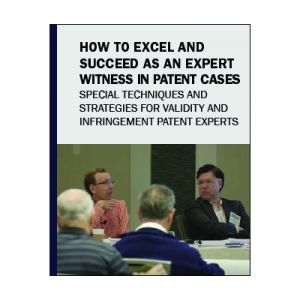Excerpted from SEAK’s Course: How to Excel as an Expert Witness in Patent Cases: Special Techniques
Keep in mind. At the other place where Claim Construction comes up is going to be a patent office proceedings. And, a critical aspect of the patent office proceeding is that they construe claims differently than District Courts. In District Court, it’s the presumption is put it in an ordinary meeting and you might hear a lawyer refer to the Philips Standard. So, Philips is a Federal Circuit case that says, “Plain and ordinary meeting applies,” absent all those different exceptions we talked about. At the patent office, so long as the patent is not expired, the patent is reviewed under what’s called “The Broadest Reasonable Interpretation Standard.” And so, that means essentially, what is the broadest reasonable meaning that this term could be given by a person who is skilled in the art at the time. And so, that allows for the claims to be construed more broadly at the patent office than they would be in District Court. So, you can sometimes, and this gets back to what I was saying earlier of the constant battle of, do you use your same expert in IPR as in litigation? Because if you use the same expert, they could litter…could be forced to construe the same words differently because there’s two different standards. You might say that the ordinary meaning under the Philips Standard’s is, X. But if I’ve asked to do the broadest feasible interpretation, it’s X plus a little bit more, X prime or something. That gives it a little bit of a difference. And that can make some awkwardness. So, that’s one reason why parties tend to use different experts between the two processes because the Patent Office uses the Broadest Reasonable Interpretation or BRI as it’s often referred to. The claims are broader and that is another reason why the patent office is considered to be an area of challenge for patent owners because their claim to be more broadly construed so there’s a bigger risk of prior art gets captured. Yes? Audience member: So does that mean you construing is different? Facilitator: So, the question is whether or not if you’re an expert in District Court and IPR, you are offering two inconsistent reports. So, if I’ve made the decision to use the same expert in both, how many of you might…there’s is no way my report’s going to be inconsistent in some way. But, you, it will be different, it will likely be different unless you can come up with a good argument for why the plain meaning is also the broadest reasonable interpretation. But, that it’s difficult because there’re two different standards. And so, in both scenarios, you’re looking to the intrinsic evidence and so, I mean the short answer is, you could be writing reports that are not necessarily inconsistent. They’re not inconsistent simply because there’s two different construction, or standards of construction. And so, you would if pressed at a deposition or by the judge, and for the jury, you would say they’re not inconsistent, is that I have two different…I’ve been asked to give two different opinions. One, I was asked, “What’s the ordinary meeting, in line with the intrinsic evidence?” The other one was, “What’s the broadest reasonable interpretation, in line with the intrinsic evidence?” So, there’s going to be differences in scope there. So that’s why there’s a very delicate balancing act and that’s why a lot of people would say, let’s have one person to the broadest reasonable interpretation and let’s have someone else to Phillips Standard and just keep it separate. And then if there’s any inconsistencies between the two descriptions of the prior art or anything, we can just throw it on that, the difference in standards and try to use that as a resolution of that issue.
